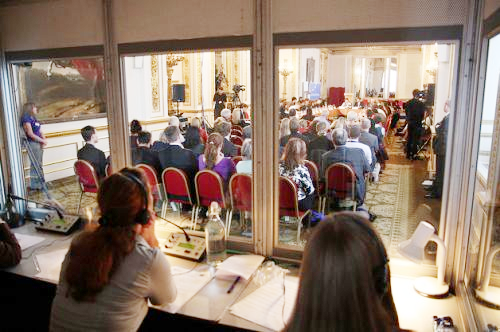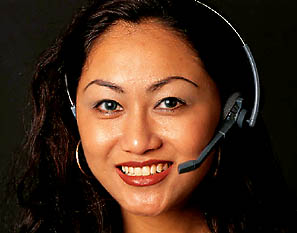Simultaneous Interpretation
The process:
| 984€ |
1,219€ |
1,524€ |
English, French, German,
Spanish and Italian |
Arabic, Portuguese, Dutch,
Russian, Polish, Czech and other
East European languages |
Chinese, Japanese, Korean,
Hindi, Scandinavian languages
and all other languages |
In simultaneous interpretation, the interpreter translates as the speaker speaks. Hence this form of translation is suitable for large or small gatherings where the speaker cannot wait in between sentences for the translator to translate. This means most gatherings with set speeches. In general, if a session of simultaneous interpretation exceeds one hour, it is necessary to have a team of at least two interpreters working together in a cabin. The main function of the cabin is to isolate the interpreters from noise from the conference room so that they can concentrate on the text of the speaker, to whom they listen via headphones. Both interpreters follow the speaker’s speech through their headphones. Each interpreter translates for ten to fifteen minutes into the microphone system and is relayed by his partner as soon as he begins to tire. The work requires such concentration and effort that this is an essential condition.
The people:
Professional interpreters are highly qualified people. The success of your conference or meeting depends on their linguistic and professional competence. Professional interpreters (also called conference interpreters) always translate towards their mother tongue, called their language A. It is very rare for an interpreter to have two A languages. Hence, if the conference must be translated perfectly into two languages simultaneously, for example into French and into English, you must consider using two teams, each translating towards their mother tongue or language A. Of course interpreters can translate in the opposite direction, i.e. from their A language to their B language. And often this solution is sufficient, for example when there are only a few persons who need the translation in the B language, and who already understand somewhat the language of the conference speakers. However it should be noted that in simultaneous translation there is a perceptible difference between an interpreter’s mother tongue (A) and his B language.
By tradition, interpreters are always paid on a daily basis, whether they work two hours or eight hours. Also, he or she is paid his full fee if the service is canceled less than two weeks before the service.
Sound Equipment:
This is a very important aspect of conferences with simultaneous interpretation. The sound from the main speakers must be carried to the translation cabin. Here the two interpreters sit with headphones and translate into a microphone. Their translation is carried by wireless transmission to the headphones which the audience members wear, to hear the translated text. All this requires specialized equipment: microphones, loudspeakers, cabin, headphones, infra red transmission, etc. and most important, a qualified technician to be present during the whole conference. We do not directly provide this service, but we can take charge of it. We work with the best professionals in the field and we guarantee the quality of the equipment and its proper functioning. A trained technician will be present throughout the conference and there will be no gaps or awkward sounds. The translation cabin is set up the day before the conference or early on the same day. The equipment is tested. An inventory is taken before and after the service.
Special Equipment for short conferences:
Whispering interpretation. For conferences less than an hour long, and which can therefore be translated by only one interpreter, we can offer you a simpler and cheaper arrangement without a full cabin, technician, microphones etc. The equipment consists only of wireless headphones (5 to 50) and a radio transmitter.
The interpreter sits at the back of the hall and whispers the translation into the transmitter. The audience hear the translation through the headphones. A cabin, heavy equipment and a technician are avoided. Whispering translation is not satisfactory for lengthy or large meetings but can suffice for small, short meetings of up to one hour.
Transcription:
We can tape record the whole or part of the conference for a small supplement. For a further fee we can also prepare a written transcript. Legally, the copyright of the translation is the intellectual property of the translator, Paris International. In case of publication, we would require at a minimum that our name be mentioned. If there are significant earnings from the translation we may negotiate a royalty.
Interpretation Request
Join us on the phone at +33 (0)1.43.31.81.69.
Or write us a mail at .
 English |
English |
 français |
français |
 español
español


